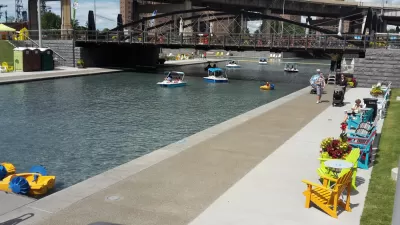Brookings has collected a year of data on an experiment it calls "transformative placemaking," with case studies from up and down the East Coast.

"By numerous measures, the Steel City is on the rise. But much of its growth and prosperity are concentrating downtown and in a handful of adjacent neighborhoods, while other neighborhoods—home primarily to people of color and high-poverty households—have yet to feel the lift," according to an article by Jennifer S. Vey and Hanna Love.
The example of Pittsburgh is cited as emblematic of similar dichotomies in other cities around the United States, and the raison d'être for a program established a year ago to address exactly these challenges. Vey and Love explain more:
One year ago this month, Brookings Metro dove into this fray with the establishment of the Bass Center for Transformative Placemaking. The impetus stemmed from the recognition that market disruptions, coupled with changing demographic and household structures, are sharpening the nation’s long-standing spatial divides—and that new sets of place-led policies and practices are essential to bridging them.
A year later, the team at the Bass Center is revealing an "outcome-oriented framework" for transformative placemaking.
The framework—meant to be adapted and refined to reflect community priorities and realities—is designed to provide stakeholders in urban, suburban, and rural areas with a holistic template for creating connected, vibrant, and inclusive communities.
According to the article, three attributes distinguish transformative placemaking from other forms of practice and public relations: scope, scale and level of integration. The article cites examples from Philadelphia, Memphis, and more to show examples of how this framework can be put into practice in different market and political environments.
FULL STORY: Transformative placemaking: A framework to create connected, vibrant, and inclusive communities

Study: Maui’s Plan to Convert Vacation Rentals to Long-Term Housing Could Cause Nearly $1 Billion Economic Loss
The plan would reduce visitor accommodation by 25,% resulting in 1,900 jobs lost.

North Texas Transit Leaders Tout Benefits of TOD for Growing Region
At a summit focused on transit-oriented development, policymakers discussed how North Texas’ expanded light rail system can serve as a tool for economic growth.

Why Should We Subsidize Public Transportation?
Many public transit agencies face financial stress due to rising costs, declining fare revenue, and declining subsidies. Transit advocates must provide a strong business case for increasing public transit funding.

How to Make US Trains Faster
Changes to boarding platforms and a switch to electric trains could improve U.S. passenger rail service without the added cost of high-speed rail.

Columbia’s Revitalized ‘Loop’ Is a Hub for Local Entrepreneurs
A focus on small businesses is helping a commercial corridor in Columbia, Missouri thrive.

Invasive Insect Threatens Minnesota’s Ash Forests
The Emerald Ash Borer is a rapidly spreading invasive pest threatening Minnesota’s ash trees, and homeowners are encouraged to plant diverse replacement species, avoid moving ash firewood, and monitor for signs of infestation.
Urban Design for Planners 1: Software Tools
This six-course series explores essential urban design concepts using open source software and equips planners with the tools they need to participate fully in the urban design process.
Planning for Universal Design
Learn the tools for implementing Universal Design in planning regulations.
City of Santa Clarita
Ascent Environmental
Institute for Housing and Urban Development Studies (IHS)
City of Grandview
Harvard GSD Executive Education
Toledo-Lucas County Plan Commissions
Salt Lake City
NYU Wagner Graduate School of Public Service





























